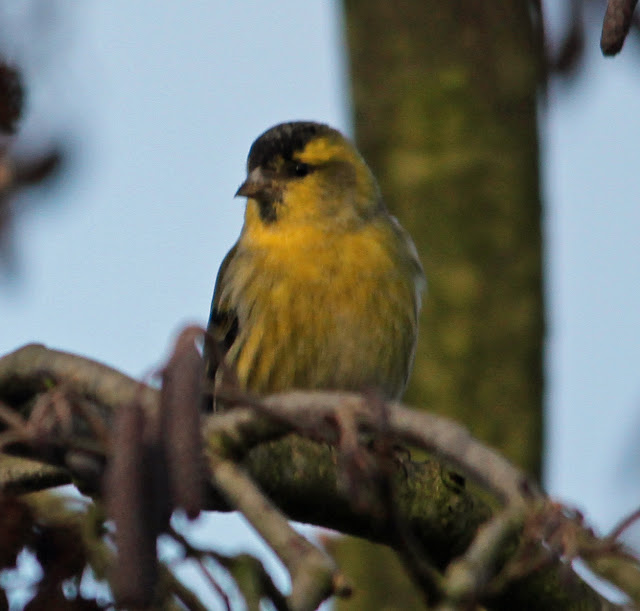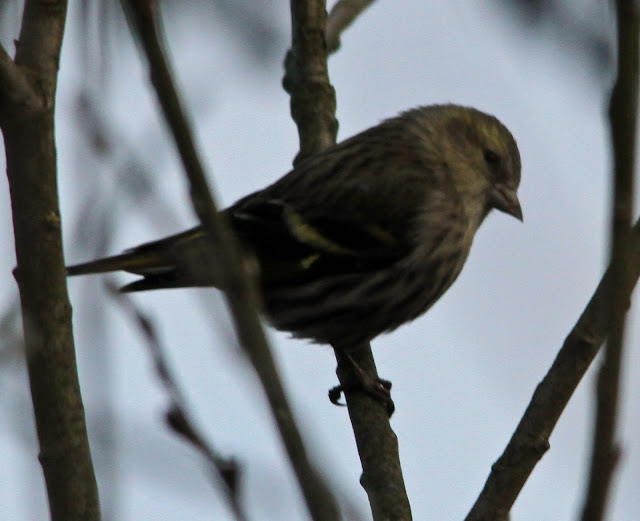Adult Herring Gull in winter plumage on Rhos Promenade showing characteristically streaky head and nape, but generally adult beak colour.
This is a more detailed shot, lightened to show the detail of the streaking and bill more clearly. This could well be a fourth winter bird, as opposed to an adult, because of the dark marks on the bill coupled with the adult red gonydeal spot, although this is quite arguable. Quite a thick bill, but not long, and probably still of the argenteus British race, as opposed to the nominate argentatus Scandinavian race.
There were also a number of Black-headed Gulls, Choirococephalus ridibundus, in various stages of gaining their breeding plumage around the head.
Here is a nice close up of the non-breeding head plumage, although there is a hint of the head-mask perhaps just darkening up:
In this front view you get a better idea of how wide the beak is as it vanishes into the head feathers:
A little bit later a small group of ducks quite far out to sea turned out to be Common Scoter, Melanitta nigra, rushing about and apparently busily squabbling with each other. I was so pleased to get confident about identifying them - this took me back to when I was about seventeen years old (FORTY years ago now!) and trying to spot these birds for sure off the East Anglian coast, and just thinking they were black dots in the distance! I haven't seen any since!
I also saw one probable drake merganser flying over the sea at Rhos, but got much better views of quite a few drakes and ducks fishing and also dashing madly around on the pools at the Conwy reserve:
and here is a duck, with the two whitish face stripes fairly clear:
and another duck - amazing how the tail spreads out flat over the water - presumably helping in controlling the pitch - certainly could be useful when preparing to dive?
and then diving - it must be a really powerful shove to get her completely underwater!
This is a second duck in a dive, just a bit further in, and just showing how the arch of the body clears the surface of the water as the head goes down and in, and the tail comes up.
This is yet another duck, also diving but this one has now got almost completely under the water. It looks as though it has used its tail as a lever to arch its body downwards to start the dive, and now the tail is following the body in the angled plane of the dive, presumably as the duck paddles downwards - unless it undulates its body to swim underwater,
and another individual duck I think:
This is the slicked down look, tail flattened against the water and the head feathers slicked back as well:
and a different duck again:
and here is a very heavily cropped duck Pochard:
and a drake:
This is a different pair of Mergansers on the other lake, with the drake leading the duck out of danger!
There were quite a few duck Goldeneye, Clangula bucephala, on the reserve as well, but I didn't see any males. Note the neat orange patch at the tip of this duck's beak, wrapped over the top of the front of the bill, just behind the nail. It has to be said that it is a very odd arrangement really:
This is a Goldeneye diving - a totally different style of dive to that of the Red Breasted Mergansers seen above.
This is a very nice (the photo doesn't do it justice) drake pochard with a smaller white patch on its bill than I've seen in most photos on the web:
This is a more detailed shot, lightened to show the detail of the streaking and bill more clearly. This could well be a fourth winter bird, as opposed to an adult, because of the dark marks on the bill coupled with the adult red gonydeal spot, although this is quite arguable. Quite a thick bill, but not long, and probably still of the argenteus British race, as opposed to the nominate argentatus Scandinavian race.
There were also a number of Black-headed Gulls, Choirococephalus ridibundus, in various stages of gaining their breeding plumage around the head.
Here is a nice close up of the non-breeding head plumage, although there is a hint of the head-mask perhaps just darkening up:
In this front view you get a better idea of how wide the beak is as it vanishes into the head feathers:
A little bit later a small group of ducks quite far out to sea turned out to be Common Scoter, Melanitta nigra, rushing about and apparently busily squabbling with each other. I was so pleased to get confident about identifying them - this took me back to when I was about seventeen years old (FORTY years ago now!) and trying to spot these birds for sure off the East Anglian coast, and just thinking they were black dots in the distance! I haven't seen any since!
I also saw one probable drake merganser flying over the sea at Rhos, but got much better views of quite a few drakes and ducks fishing and also dashing madly around on the pools at the Conwy reserve:
and here is a duck, with the two whitish face stripes fairly clear:
and another duck - amazing how the tail spreads out flat over the water - presumably helping in controlling the pitch - certainly could be useful when preparing to dive?
and then diving - it must be a really powerful shove to get her completely underwater!
This is a second duck in a dive, just a bit further in, and just showing how the arch of the body clears the surface of the water as the head goes down and in, and the tail comes up.
This is yet another duck, also diving but this one has now got almost completely under the water. It looks as though it has used its tail as a lever to arch its body downwards to start the dive, and now the tail is following the body in the angled plane of the dive, presumably as the duck paddles downwards - unless it undulates its body to swim underwater,
and another individual duck I think:
This is the slicked down look, tail flattened against the water and the head feathers slicked back as well:
and a different duck again:
and here is a very heavily cropped duck Pochard:
and a drake:
This is a different pair of Mergansers on the other lake, with the drake leading the duck out of danger!
There were quite a few duck Goldeneye, Clangula bucephala, on the reserve as well, but I didn't see any males. Note the neat orange patch at the tip of this duck's beak, wrapped over the top of the front of the bill, just behind the nail. It has to be said that it is a very odd arrangement really:
This is a Goldeneye diving - a totally different style of dive to that of the Red Breasted Mergansers seen above.
This is a very nice (the photo doesn't do it justice) drake pochard with a smaller white patch on its bill than I've seen in most photos on the web:















































